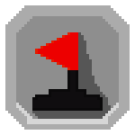While many classic video games have faded into nostalgia and obscurity, one unassuming logic puzzler has managed to maintain a dedicated global audience for over three decades – Minesweeper. This simple but addictive game of strategy and deduction has captivated millions of people with its elegant, minimalist design that hides surprising depth. However, few realize just how fervent Campo Minado’s fan base is in the Spanish-speaking world, where the game has achieved an iconic status that rivals that of traditional classics such as chess.
The Origins of the Minefield
Minesweeper’s origins date back to the early 1960s with games like Ye Classic Complementary Software Product, but its popularity was widespread when it was included in the Microsoft Entertainment Pack in 1990 and later as a pre-installed game in Windows 3.1 in 1992. Its stylized depictions of naval mines and simple rules – using logic to deduce the placement of mines on a grid – made it an instant hit all over the world.
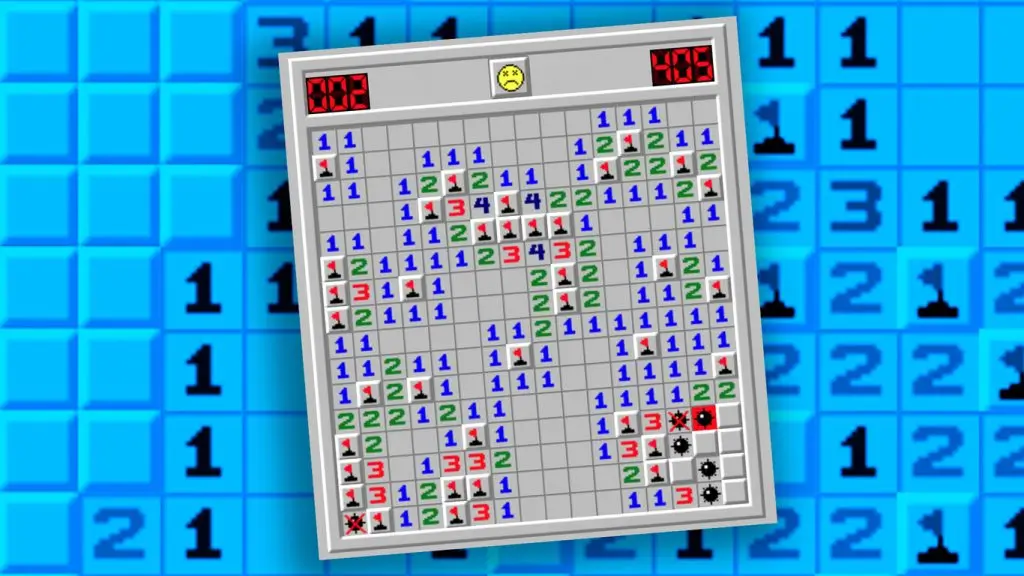
Minesweeper classic game
In Spanish-speaking countries, however, Minesweeper seemed to have a special impact. From Spain and Mexico to Peru, Argentina and Colombia, players of all ages were quickly attracted to the game’s strange dichotomy – simple on the surface, but capable of creating deep logical and cognitive challenges underneath. What started out as a fun time-killer for many quickly became an obsession as people strove to master the higher difficulty levels.
| Attribute | Game description |
| Type of game | Logic Puzzle, Video Game |
| Origin | Microsoft Windows 3.1 (1992) |
| Creators | Robert Donner, Curt Johnson |
| Objective | Open all the safe squares without detonating the mines |
| Gameplay | Use numerical clues to deduce the location of mines |
| Levels of difficulty | Beginner, Intermediate, Expert, Customized |
| Competitive scene | Grand Masters, World Championships, Speedrunning |
| Variations | Minesweeper X, Crossmines, Minesweeper Casino |
| Cultural impact | Worldwide popularity, educational applications, mental exercise |
Minefield Across Cultures
Part of Minesweeper’s enduring appeal lies in its refreshing lack of economic, age or skill barriers. Unlike big-budget video game releases that require expensive hardware and mastery of complex controls, this unpretentious logic game runs on any basic computer and can be learned in minutes through trial and error, but contains virtually unlimited potential for developing logical thinking skills.
As such, “Buscaminas”, as it is known in Latin America and Spain, has overcome all socio-economic barriers to unite generations of players. From office workers facing endless downtime, to students procrastinating between classes, to pensioners looking for a fun mental workout, everyone has found reasons to embrace the game’s simple yet fiendishly absorbing gameplay.
Minesweeper Rules: How to Play
Minefield is a logic and deduction game in which the aim is to open all the safe squares in a grid without detonating any hidden mines. The grid contains hidden “mines” scattered at random, the only clues being the numbers in the squares which indicate how many mines are positioned in the eight surrounding squares.
To begin with, players can left-click on any square to reveal what’s underneath. If it’s a mine, the game ends in catastrophic failure. However, if the tile clicked on is safe, it will either remain blank (indicating that there are no mines in the adjacent squares) or show a number indicating how many mines there are in that particular square.
Strategic Game
Using these numerical clues, players can gradually calculate the position of the mines through careful logical deduction and probabilities. Squares where mines are suspected can be preliminarily marked with a flag by right-clicking. The precise placement of the flags is crucial, since incorrectly marking a safe square means losing the game if it is clicked.
As more safe squares are cleared, players can begin to employ minesweeper tactics such as pattern recognition, grouped number inference and complex probability calculations to speed up the mine clearance process. For advanced players, techniques such as “click 1.5” and algorithms to determine the likely location of mines with limited clues become invaluable.
Minesweeper Levels
To cater for different skill levels, Minesweeper has three classic difficulty levels that dictate the size of the grid and the density of the mines:
- Beginner: An 8×8 or 9×9 grid with only 10 mines
- Intermediate: A 16×16 grid with 40 mines
- Specialist: The brutal 30×16 grid with 99 randomly scattered mines
What’s more, many versions allow you to create custom games to adjust the grid dimensions and mine count for an extra challenge.
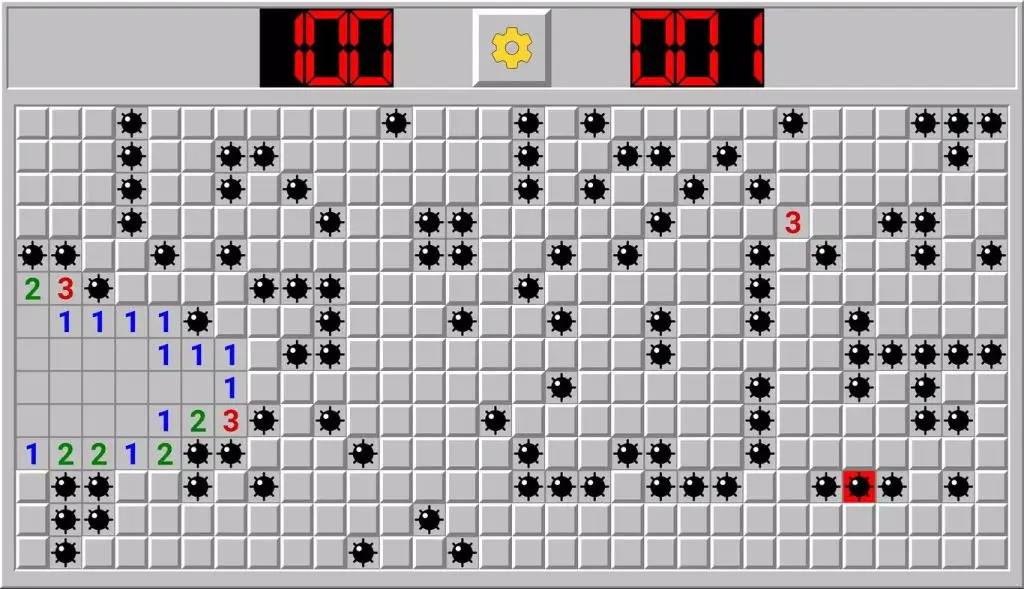
Minesweeper gameplay
Minefield Patterns
Identifying visual patterns is a crucial skill for Minesweeper masters. Even at beginner levels, the simple patterns of edges and corners provide basic techniques for deducing the location of mines based on the process of elimination using the board’s boundaries. A “1” in the first row automatically means that the only adjacent square contains a mine, while a “3” in a corner square reveals that the three neighboring squares on the diagonal must be mines.
As players progress to more difficult grids, they have to recognize advanced patterns such as “Snakes” (linear sequences of ascending/descending numbers), “Two-Three Splits”, “Double Bingos” and various other impressive geometric shapes created by the number tracks. The great masters develop a “board vision” that allows them to instantly understand these comprehensive patterns and map out entire swathes of the minefield almost by instinct. Through exhaustive study and repetition, the numbers transcend individual data points and merge into radiant holistic geometries that reveal the underlying logical architecture – a kind of hidden secret code waiting to be perceived by those who train their eyes.
Where to Make the First Click in the Minefield
In Minesweeper, a classic puzzle game, the strategic positioning of the first click can greatly influence the ease and success of the game. Most players instinctively start with a random click, hoping to discover an “opening”, a set of squares without mines, which reveals numbers that provide clues to the location of nearby mines. A popular strategy suggests clicking near the center of the grid. This is because a click in the middle is more likely to create a larger opening, offering more information and a wider area to work with at the start of the game, thus making the initial puzzle-solving phase easier.
However, although central clicks tend to generate larger openings, the actual probability of obtaining an opening increases as you get closer to the edges of the grid. This dichotomy presents a strategic choice: opt for potentially larger but less likely openings in the center, or opt for more likely but smaller openings near the edges.
Tim Kostka’s exhaustive analysis in 2002 clarified this dilemma for the different difficulty levels of Windows Minesweeper: Beginner (8×8), Intermediate (16×16) and Expert. His findings revealed that the average size of the openings varies significantly across all levels, with:
- Beginner-level openings ranging from 18 to 32 squares,
- intermediate level openings of 27 to 66 houses, and
- Specialist level openings from 16 to 41 houses.
Furthermore, the probability of an opening also varies, with the Beginner level ranging between 0.19 and 0.60, Intermediate between 0.21 and 0.60 and Expert between 0.12 and 0.50. These figures suggest that while central clicks can be beneficial for their potential to reveal large areas of the board, the edges offer a more reliable chance of creating an opening, albeit typically a smaller one.

Minefield Games
Minesweeper Tips and Tricks for Players of All Levels
Before you even make your first click, there are some useful settings and adjustments to improve your experience in Minesweeper:
- Opens the options menu and deactivates the question mark function. This allows you to quickly remove incorrect marks with just one click instead of two.
- Get used to restarting games with the F2 key instead of using the menu or the smiley button. Keeping one finger anchored to this keyboard shortcut saves precious milliseconds.
- For a warm-up, try playing with background music, which can help your subconscious concentrate better by occupying the conscious parts of your brain.
- Make sure you have an ergonomic and well-fitting mouse to avoid strain injuries such as carpal tunnel syndrome, which has sidelined many elite players.
Tactical Game Tricks
Once you’ve optimized your environment, you can start implementing smart techniques to improve your skills:
- If you accidentally click on a mine, you can quickly slide the cursor to a safe square before releasing the mouse button to avoid detonation.
- Completely ignore the timer when playing – constantly looking at the clock leads to rash decisions and mistakes.
- Train your eyes to analyze the frames without having to follow the mouse cursor, which speeds up processing.
- Practice the flagged and unflagged resolution styles, allowing you to switch between them fluidly and without pause as the scenarios require.
- Periodically increase the difficulty by creating customized games with higher mine densities to speed up your pattern recognition skills.
Going Beyond your Limits
Even experienced Minesweeper masters can benefit from occasionally transcending their usual comfort zones with exercises such as:
- Try full-speed races, where careless mistakes are allowed, in order to broaden your perceptions and high-speed reactions.
- Taking regular breaks to get away, exercise and increase blood flow measurably improves cognitive faculties and motor skills.
- Playing in warmer ambient temperatures, which have been shown to increase reaction times by improving hand dexterity through increased circulation.
With basic optimizations, clever tactical tweaks, and a willingness to periodically push your skills into new territory, any Minesweeper enthusiast can constantly raise their game to shave precious hundredths of seconds off their fastest clearing times. Implementing minesweeper tricks, such as periodically cleaning the mouse roller ball, ensures that no traces of 90s technology sabotage your hard work. This practice is crucial for maintaining smooth and precise control during gameplay.
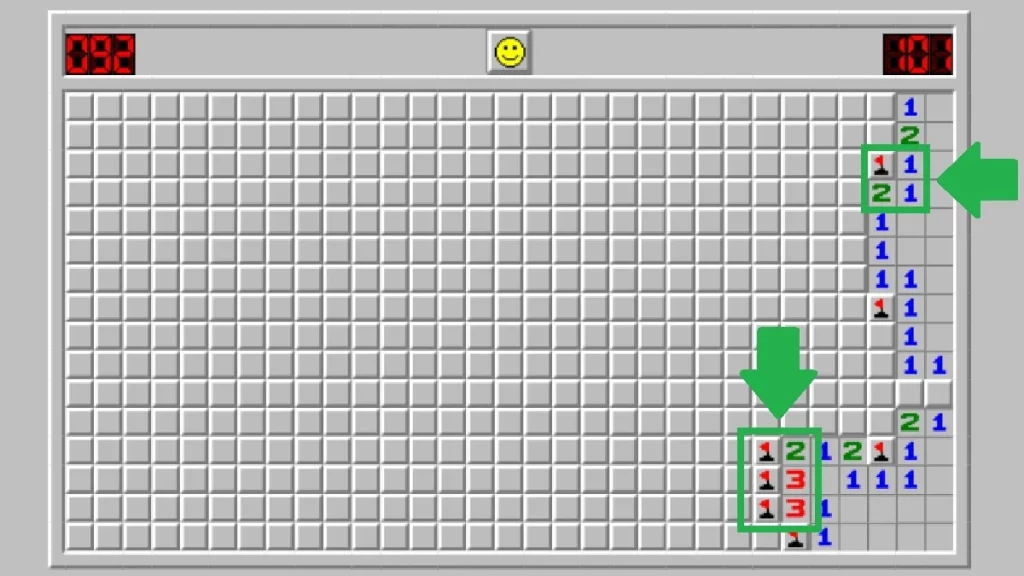
Minefield strategies
How to Play Minesweeper for Real Money
Although Minesweeper may have started life as a simple time-killer included in the first Windows operating systems, the addictive logic game has become a legitimate online gambling vertical in its own right. Many virtual casinos and gambling sites now offer their own unique variations of Minesweeper that can be played with real money stakes and payouts.
These Minesweeper casino games retain the core gameplay of strategically removing mines from a grid using logic and probability deduction. However, they introduce additional elements such as timed scoring systems, bonus round mechanics and special items that can tip the odds in the players’ favor. Some even gamify the experience with dramatic mine animations and thematic elements inspired by adventure games or Las Vegas casino floors.
Start Playing Minesweeper for Real Money
For those who are intrigued by this digital evolution of the classic high-stakes game, getting started is relatively simple:
- Find a reputable online casino that offers variants of Minesweeper for real money as part of its “special games” catalog. Trustworthy sites are licensed and regulated to ensure fair play.
- Create an account on the casino’s website and make an initial deposit to have funds available for Minesweeper betting. Most allow a variety of secure payment methods.
- Select your favorite Minesweeper game type, set your bet amount and start playing! Most casinos offer free tutorials or demo modes to learn the specific rules.
- As you strategically clear mines and reach designated score/objective thresholds, your payouts accumulate based on the predetermined payout schedule for that round.
- Winnings can then be withdrawn from your casino account or used to place further bets on Minesweeper or other casino games.
Although not as immediately lucrative as slots, blackjack or poker, Minesweeper’s mental training element and calculated risk/reward cycle have proven addictive for many online players looking for a cerebral edge. With real money at stake, the ticking of the clock becomes substantially more stressful as players grapple with the finer moves of game theory.
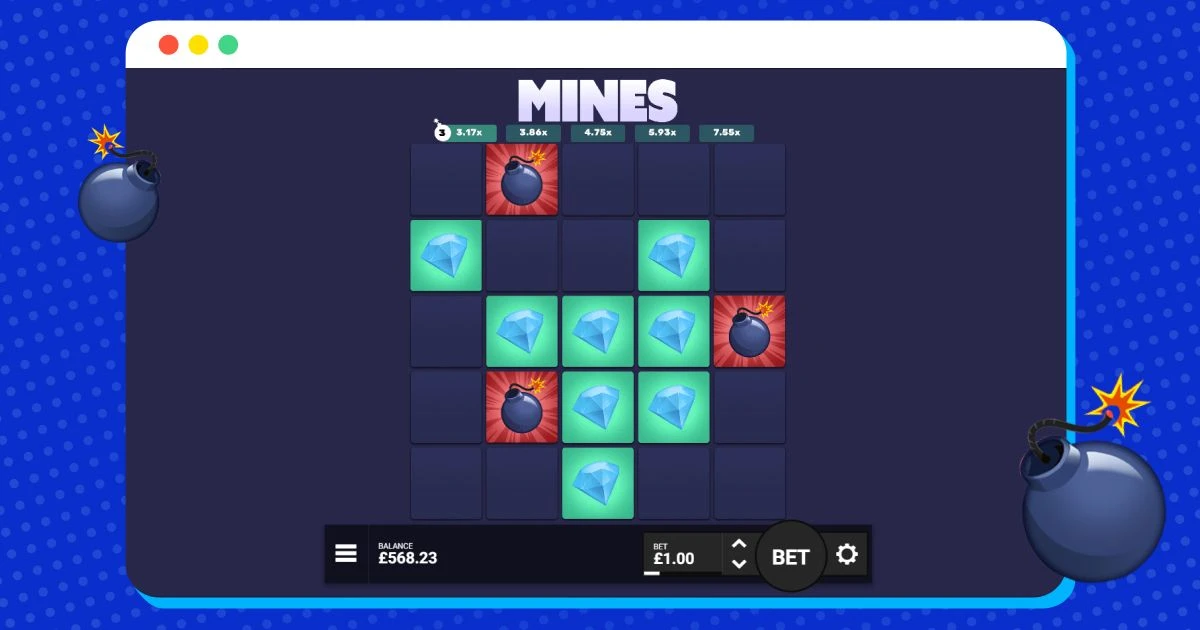
Minefield casino game
Google’s Minefield
Google Minesweeper refers to the version of the classic puzzle game Minesweeper that is accessible through Google’s services or platforms, such as its search engine or as part of its set of doodle games. This digital version retains the core gameplay of the traditional Minesweeper game, in which players click on tiles to reveal numbers indicating the number of mines on adjacent tiles, with the aim of clearing the board without detonating any mines.
The Google version of Minesweeper can be found simply by searching for “Minesweeper” in the Google search engine, leading to an instantly playable version of the game on the search results page. This accessibility makes it a convenient option for users looking to enjoy the game without the need to download an application or access a separate gaming platform. For those seeking an edge, exploring tips on Minesweeper can enhance both new and experienced players’ strategies. The game typically features various levels of difficulty, from beginner to expert. The interface is clean and straightforward, favoring a user-friendly design consistent with Google’s other offerings.
The Minefield World Record for Experts
Among the hallowed achievements in the competitive world of Minesweeper, few accomplishments are more coveted than the world record for the fastest completion of the expert level. The expert level represents the ultimate test of a player’s logical dexterity and mental stamina, with a daunting 16×30 grid loaded with 99 randomly scattered mines waiting to punish the slightest mental lapse.
For more than a decade, the world record for the Minesweeper was 31.16 seconds, set by Polish grandmaster Kamil Muranski in 2010. Then, in 2020, a 12-year-old prodigy called Ze-En Ju shocked the Minesweeping community by obliterating Muranski’s mark with an almost supernatural speed of 29.43 seconds – a staggering 1.7-second improvement on what was considered cutting-edge just a few years earlier.
Fast Running Phenomenon Minefield
Ju’s achievement underlined the rapid evolution of Minesweeper as a sphere for elite competitive speedrunning disciplines. While casual players can spend dozens of idyllic minutes meticulously examining a specialized board, at the highest echelons, the grand masters have elevated the game into a unique kind of competitive e-sport. Combining the precision of quick clicks, pattern recognition and mind-boggling all-or-nothing probability calculations, these masters chase records down to the hundredth of a second.
It’s a dizzying display of mental acuity and unwavering concentration. The best speedrunners in the Minefield use advanced minesweeper tips and techniques such as the “1.5 click” maneuver and cutting-edge methodologies to instantly deduce the location of mines based on scant numerical evidence. To watch recordings of Ju’s world record run is to witness a kind of fleet-footed, high-speed chess savant synthesizing millions of intricate logical calculations per second in a virtuoso sweep across the grid.
Records in All Difficulties
Although expert times represent the pinnacle of Minesweeper prowess, speedrunning talents like Ju have set incredible records at all levels of difficulty:
- Beginner (8×8, 10 mines): The current world record of 0.09 seconds, set by Dmitriy Batskatov in 2022, is an almost physiologically improbable demonstration of supernatural reflexes and instant calculation of probabilities.
- Intermediate (16×16, 40 mines): Ju himself holds the 2nd fastest time here with 8.76 seconds, just a quarter of a second off the world record of 8.46 seconds.
- Specialist (16×30, 99 mines): And, of course, Ju’s blitzkrieg of 29.43 seconds marks the current ne plus ultra in the territory of the grand master of the Minesweeper.
New Technologies
In this sense, rather than allowing the game to become obsolete, new technologies have fueled a real renaissance of Campo Minado in Latin America and Spain. In recent years, interactive exhibitions have celebrated the mathematical concepts behind the game. Universities have incorporated it into courses to promote skills such as logical reasoning and pattern recognition. There are even professional tutors and trainers who offer to perfect the strategic and psychological skills of Campo Minado players.
Conclusion
Minesweeper, a game that started out as a simple time killer, has evolved into a global phenomenon that transcends age, skill level and culture. From its humble origins as a pre-installed game on Windows, it has become a beloved classic that has stood the test of time, captivating players with its deceptively simple yet deeply challenging gameplay.
Minesweeper has also embraced new technologies, evolving into a complete renaissance with interactive exhibitions, university courses and even professional tutors dedicated to honing players’ strategic and psychological skills. The emergence of online casinos offering real-money variants of Minesweeper has further solidified the game’s place in popular culture, blurring the lines between entertainment and high-risk thrills.
Frequently Asked Questions
What is the Minefield?
Minefield is a logic game in which players must use numerical clues to deduce the location of the mines hidden in a grid, opening all the safe squares without detonating any mines.
How do you play Minesweeper?
Players click on the squares to reveal a number that indicates how many adjacent squares contain mines or an empty square. Using this information, players strategically flag suspected mine locations and open safe squares until the entire board is cleared.
What are the different levels of difficulty in Minesweeper?
The classic difficulty levels are Beginner (8x8 or 9x9 grid with 10 mines), Intermediate (16x16 grid with 40 mines) and Expert (16x30 grid with 99 mines). Many versions also allow you to create custom games.
Is it possible to play Minesweeper for real money?
Yes, several online casinos now offer variations of Minesweeper for real money with additional features such as timed scoring systems, bonus rounds and special power-ups.
What are some of the advanced Minesweeper techniques?
Advanced techniques include pattern recognition (e.g. 'Snakes', 'Two-Three Splits'), the '1.5 click' maneuver, algorithms to determine the probabilistic location of mines and the development of an intuitive 'board view'.
How can I improve my Minefield skills?
Practice regularly, study recorded games from great masters, try custom games with higher mine densities and implement minesweeper tips such as disabling question marks, using keyboard shortcuts and optimizing the physical setup and environment.
